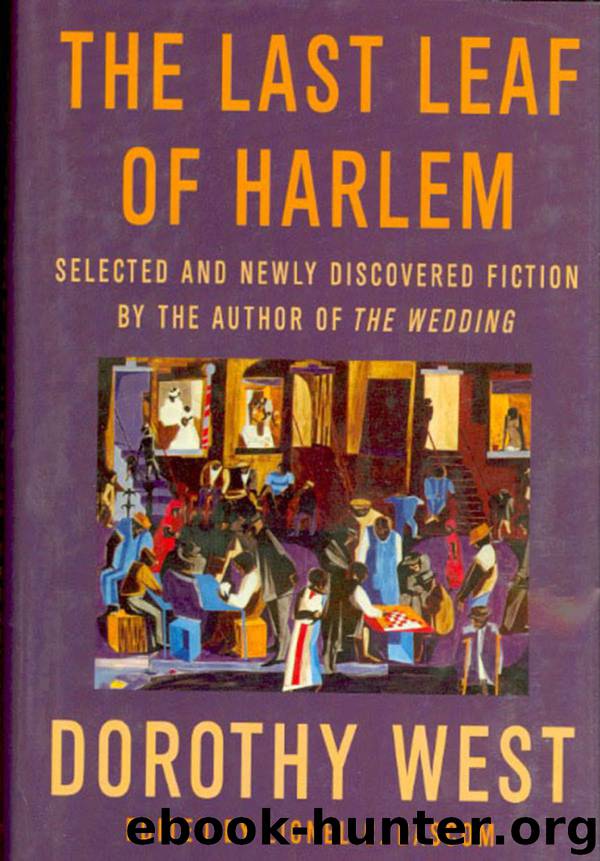The Last Leaf of Harlem by Lionel Bascom

Author:Lionel Bascom [Bascom, Lionel]
Language: eng
Format: epub
Publisher: Lionel Bascom
Published: 0101-01-01T00:00:00+00:00
The Assimilationist Period
After “Jack in the Pot” appeared in 1940, West began a new era in her career. She was now able to sell her fiction regularly to the New York Daily News and the News Syndicate. The syndicate bought and distributed her short stories to member newspapers in cities throughout the world.
It is not clear how many newspapers picked up these stories but it is safe to say her readers now numbered in the millions. Syndicates make their money selling the features they publish to a large number of newspapers in the same way they sell comic strips. The fiction Dorothy West was writing after 1940 now appeared regularly in the New York Daily News, one of the largest daily circulated newspapers in the United States with a daily circulation of well over a million readers.
The same stories seen in the New York metropolitan area were even more widely circulated when they were picked up by newspapers which subscribed to the News Syndicate. This fact alone suggests that Dorothy West may have been among the most widely read writers of the Harlem Renaissance due to this long relationship with the News and the syndicate. It continued for more than twenty years with West writing between one and three stories a year.
As you will see, these stories are driven by plots in which a moral message is the central theme. Significantly, her characters are not identified in the narrative as members of any particular racial group. When examined closely, in fact, these are raceless characters for the most part. If the narrative stood alone, a reader could safely assume West and her publishers intended to avoid the issue of the author’s race or the issue of race altogether.
While West was never identified as a black writer, the more than forty stories she wrote for the News during this period were illustrated with drawings that clearly depict white characters. This editorial decision to drop in sketches of white men, women and children in stories where the race of the central characters is obscured, suggests that the editors deliberately intended to obscured the race of the author.
This situation never became a major issue during West’s long life although she has said she was criticized for writing pulp fiction instead of the literary fiction she was known for writing.
This brings up an obvious question. Was she passing herself off as a white writer?
Most likely, not.
A more likely story concerns the politics of race and publishing the work of blacks in the 1940s and succeeding decades. According to West, she was instructed to write stories about whites, not blacks.
The so-called “protest literature” her contemporaries from Harlem and other regions were writing, decried the plight of Negroes in America. After the Renaissance period of the late 1920s, this genre of writing from blacks was not well received or widely read in wider publishing circles. In order to be published, West and other black writers deliberately began to write stories with plots that were no longer dependent upon a black perspective or point of view.
Download
This site does not store any files on its server. We only index and link to content provided by other sites. Please contact the content providers to delete copyright contents if any and email us, we'll remove relevant links or contents immediately.
Red by Erica Spindler(12038)
Crooked Kingdom: Book 2 (Six of Crows) by Bardugo Leigh(11981)
Twisted Palace by Erin Watt(10858)
Fangirl by Rainbow Rowell(8805)
Mindhunter: Inside the FBI's Elite Serial Crime Unit by John E. Douglas & Mark Olshaker(8722)
Never let me go by Kazuo Ishiguro(8334)
All the Light We Cannot See: A Novel by Anthony Doerr(8281)
A Man Called Ove: A Novel by Fredrik Backman(8201)
Confessions of an Ugly Stepsister by Gregory Maguire(7676)
The Lover by Duras Marguerite(7591)
Little Fires Everywhere by Celeste Ng(6881)
The Vegetarian by Han Kang(6070)
To All the Boys I've Loved Before by Jenny Han(5605)
The Shadow Of The Wind by Carlos Ruiz Zafón(5435)
On the Yard (New York Review Books Classics) by Braly Malcolm(5396)
Keepsake: True North #2 by Sarina Bowen(5314)
Dancing After Hours by Andre Dubus(5116)
Ken Follett - World without end by Ken Follett(4450)
The Perks of Being a Wallflower by Stephen Chbosky(4414)
